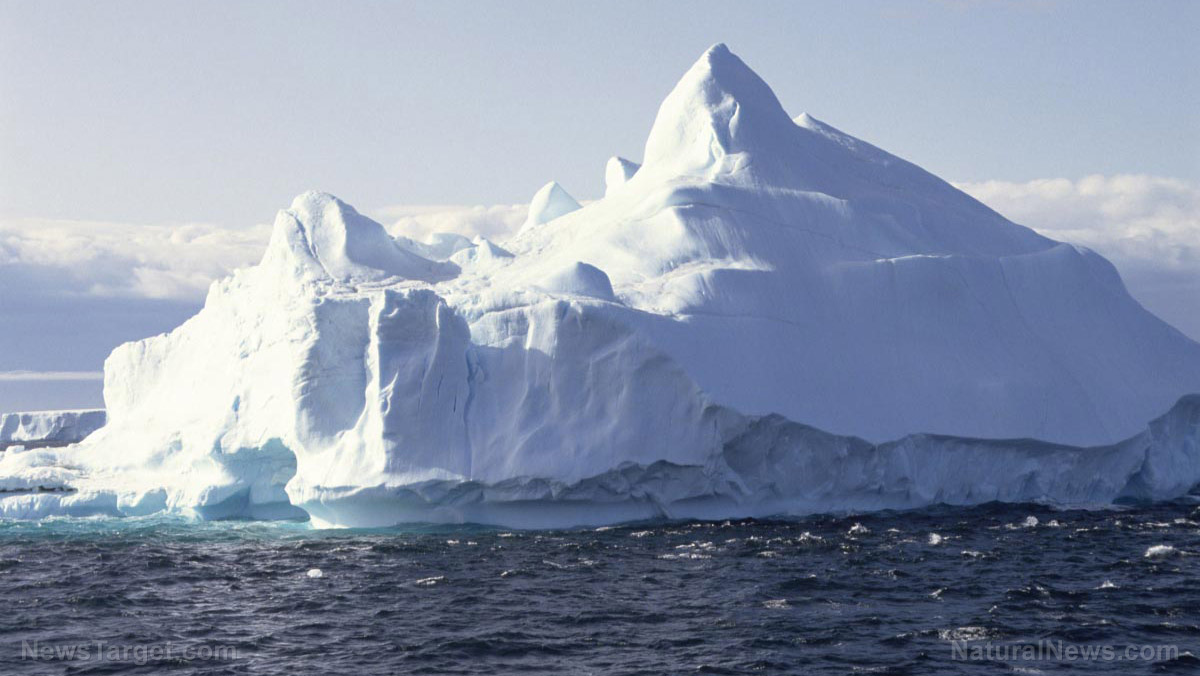Experts say the world’s biggest iceberg is drifting fast after being stuck in one spot for 30 years
12/06/2023 / By Zoey Sky

The Antarctic iceberg A23a, known as the world’s biggest iceberg, is a block of ice that is at least 4,000 square km (1,500 square miles). The tooth-shaped iceberg is roughly three times the size of New York City and is massive at 1,312 feet thick.
After 30 years of being “stuck” on the spot, iceberg A23a is finally on the move.
According to data, A23a is being moved northwards by wind and ocean currents “at speed” after it has been grounded by the ocean floor for 30 years.
Iceberg A23a’s breakdown could threaten ships and wildlife
Researchers have reported that A23a is slowly drifting past the Antarctic Peninsula, a piece of land that sticks out from the mainland like a tail, and should break down because of rougher waters once it reaches the open ocean.
Researchers track objects as big as A23a constantly after the break-off because they could pose a threat to ships and wildlife.
Compared to many of the large icebergs that detach from Antarctica and float away, A23a had only moved several hundred miles since it broke off from the Filchner Ice Shelf in August 1986.
The iceberg’s lack of movement was because it was “grounded’ or stuck on the sea floor. Because of this, A23a is less vulnerable to fragmenting.
But recent reports say that the massive iceberg has finally broken free.
Icebergs “ground” on the ocean floor when their keel, the term for the part of an iceberg that is below the water’s surface, is deeper than the water’s depth. (Related: The Sahara Desert is SHRINKING as plants grow, land becomes more GREEN, thanks to rising CO2.)
Dr. Andrew Fleming, a remote sensing expert from the British Antarctic Survey, explained that he spotted the first signs of movement from A23a as early as 2020.
Fleming said A23a has been grounded since 1986, “but eventually it was going to decrease in size sufficiently to lose grip and start moving.” He added that researchers like him have wondered “if there was any possible change in shelf water temperatures that might have provoked it,” but they all agreed that the iceberg has now broken free because “the time had just come.”
Lindy Elkins-Tanton, a planetary scientist, posted on X (formerly Twitter) and announced that she is part of a voyage on the way to visit A23a.
A23a could soon reach the Antarctic Circumpolar Current
Iceberg A23a is slated to reach the Antarctic Circumpolar Current, a 13,000-mile loop of ocean water that flows around Antarctica.
Experts have predicted that the iceberg could become grounded again near South Georgia, an island further north in the southern Atlantic Ocean. The area is a hotspot for seals and seabirds.
Oliver Marsh, a British Antarctic Survey glaciologist, explained that it is rare to see an iceberg of A23a’s size on the move, which is why scientists will be observing its trajectory closely.
As it gains steam, A23a could eventually reach the Southern Ocean on a path called “iceberg alley” where other icebergs can also be seen floating in dark waters. If this happens, experts are worried that A23a could disrupt the feeding routines of the creatures, especially if it ends up in an area where foraging usually happens.
But if A23a melts, minerals released from the ice could be beneficial since this will provide nutrients for organisms at the bottom of ocean food chains.
Dr. Catherine Walker at the Woods Hole Oceanographic Institution in Massachusetts said icebergs are also “life-giving” because they are the origin point for a lot of biological activity.
The record for the largest current iceberg changes every few years, particularly when new icebergs are calved off the Antarctic continent and eventually break into smaller fragments.
Rising waters and air temperatures have resulted in “triggering instabilities” along the coasts of Antarctica and Greenland, accelerating melting and increasing the rates of calving or the breaking of ice chunks from the edge of a glacier.
The former record holder was A76, an iceberg that detached from an ice shelf in the Weddell Sea in May 2021, but it has since fragmented into three pieces.
Ice shelves are large floating platforms of ice that connect to a landmass, such as Antarctica, but they can also be found in other polar locations such as Greenland.
The Guinness World Records reports that the largest iceberg was a little over 31,000 sq km (12,000 sq miles), or bigger than Belgium. The huge iceberg was seen 150 miles west of Scott Island, in the Southern Ocean by the USS Glacier on November 12, 1956.
Visit Environ.news for more stories like this.
Watch the video below for more about iceberg A23a’s movement.
This video is from the High Hopes channel on Brighteon.com.
More related stories:
Cocoa prices rise to highest level in 45 years as poor weather diminishes outlook for harvests.
The climate-change religion: How long before human sacrifices?
Sources include:
Submit a correction >>
Tagged Under:
A23a, Antarctic Circumpolar Current, Antarctica, Dangerous, discoveries, Ecology, environment, iceberg A23a, icebergs, ocean health, research, weird science
This article may contain statements that reflect the opinion of the author




















